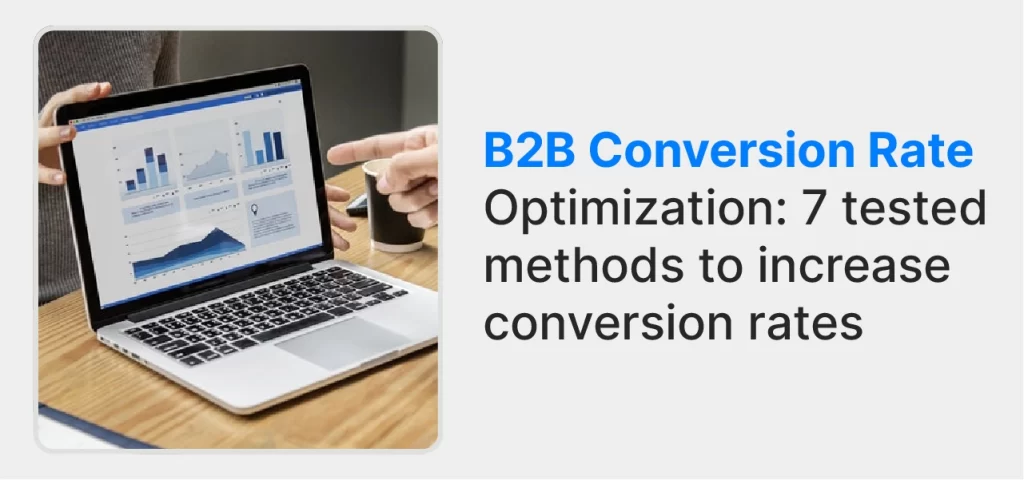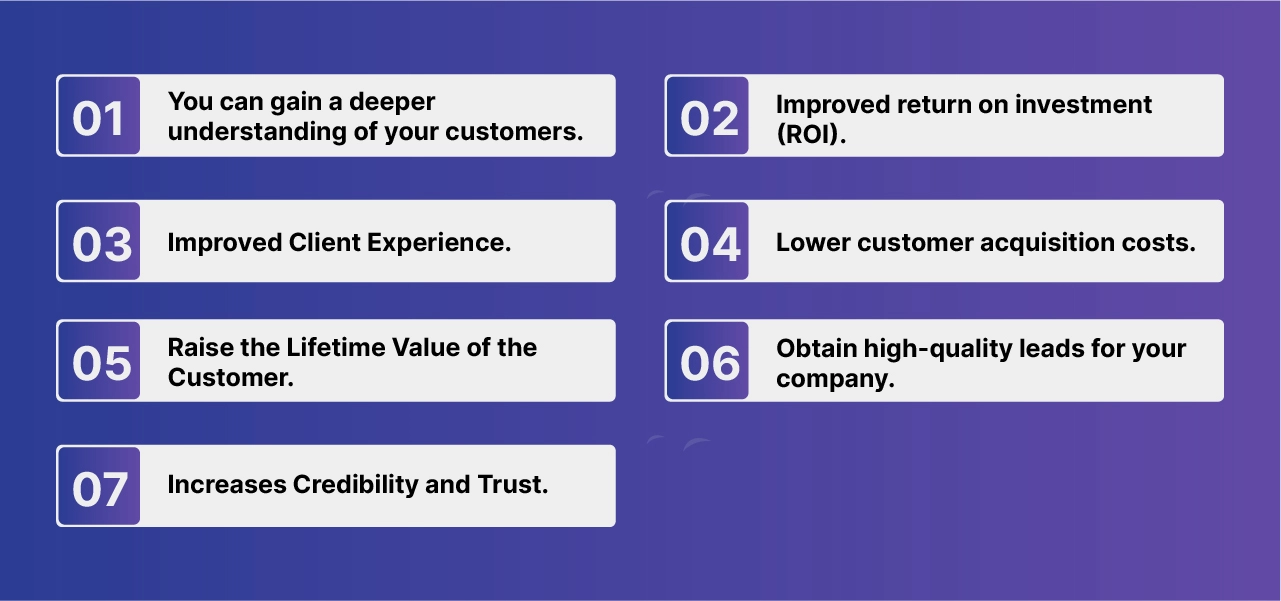
B2B Conversion Rate Optimization: 7 tested methods to increase conversion rates
Conversion Rate Optimization (CRO) refers to increasing the likelihood of a user completing a specific goal on your website.
This is essential for effective B2B lead generation and can take the form of ordering a product, asking for a price, or downloading a white paper.
Despite how important CRO is, it’s simple for marketers to become preoccupied with generating traffic and pay little attention to optimising their website.
The success of any campaign depends on your ability to convert the traffic you send from the research team, as CRO is still only one component of the customer decision-making process.
What is Conversion Rate Optimization?

Conversion rate optimization, or CRO, is the process of enhancing your website to increase the number of leads you generate.
CRO is achieved through content enhancements, split testing, and workflow improvements. Conversion rate optimization results in highly-qualified leads, increased revenue, and lower acquisition costs.
What is a B2B conversion rate optimization?
Selling to a business is the same as selling to a customer. The main difference is that B2B buyers are more serious about their purchases. According to Forrester research, the majority of B2B buyers prefer to perform their own research rather than rely on a sales representative for information.
This provides an opportunity for your company to directly influence your buyers by just having a stable internet presence. It is critical to understand that conversion optimization is more than just adding eye-catching Call to Actions (CTAs).
It is a step-by-step procedure for modifying and upgrading each part of your digital marketing presence in order to increase the percentage of people who perform the desired action on your website.
7 Tested Methods to Increase B2B Conversion Rates

Now that you are aware of the importance of B2B conversion optimization for the development and expansion of your company, it is time to look at some of the tried-and-true strategies you can use to see results right now.
1. Simplify client interactions
The largest error B2B marketers make is over-complicating their user interfaces and conversion funnels. One of the factors that leads potential clients to other websites in search of a better user experience is this frequently skipped step.
If you want to maintain your website’s distinctive and edgy appearance, that’s acceptable. What happens, though, if potential buyers are unable to find the items they’re looking for in your store?
They ultimately leave your website with an empty shopping basket and the purpose to never come back to your shop.
More than 26% of customers abandon their shopping carts at the last minute because they think the checkout process is too difficult –Baymard Institute study
2. Invest in a content marketing plan
As was already established, clients who purchase from drop-shipping stores are less interested in obtaining technical knowledge than B2B buyers. Invest in a cost-effective content marketing plan that will enable you to connect with potential clients.
The secret is to provide top-notch, optimised content that provides significant value to visitors to your website. Keep in mind that you cannot expect an increase in your conversion rate if your content is not valuable and people are not consuming it.
Start by distributing straightforward but engaging newsletters. For your new prospects and devoted clients, you can create case studies and beginner’s instructions, respectively. Displaying testimonials on your website will also encourage conversions from other visitors as they serve as social proof.
3. Combining SEO and PPC
For online businesses to succeed, pay per click (PPC) and search engine optimization (SEO) are both essential. However, each of these features has advantages and disadvantages, making it difficult for marketers to decide which to emphasise.
The goal of SEO tactics is to increase organic traffic. However, it is also true that its effects are gradual and that companies must wait a considerable amount of time before observing any real-time effects.
PPC, on the other hand, is more rapid and outcome-focused. It is indeed pricey. But with paid advertising initiatives, you can see conversions. The good news is that PPC and SEO are no longer mutually exclusive.
They can be combined to raise your conversion rates. One of the most straightforward instances is using keywords generated by SEO to improve your PPC advertising.
4. Use the most effective retargeting strategies
You can retarget visitors or clients who have previously expressed interest in your items instead of spending your time and money on prospects who are uninterested in your offerings. Send them advertisements for goods in which they have already expressed interest.
5. Optimize your landing pages
As was previously mentioned, companies that send visitors to their landing sites rather than a generic homepage see greater results. However, will this increase your conversion rate? No.
Your landing pages must be optimised by having strong CTAs, a straightforward design, and clear navigation. Keep distractions to a minimum while A/B testing your sites’ colour schemes, designs, and CTAs. Additionally, check to see if your landing pages are mobile- and browser-compatible.
6. Include trust seals on your website.
B2B business models are more difficult because you have to work with specialists rather than common clients. Since these visitors are already knowledgeable about technological details, you must make sure that your website is professionally designed in every way.
Display trust seals on your website to show visitors that your company values their security and privacy.
To reassure customers that your products are worth their money, you should also display quality assurance certificates, if you have any.
Displaying an SSL certificate is essential for B2B companies as it reassures customers that their data is secure and secured.
7. Monitor Your Engagement and Analytics Data
Better conversion rates are not always guaranteed by the sheer number of visitors to your website. Why? Considering that not every website visitor is a qualified lead. We advise you to look at the analytics specific to each page of your website rather than your website stats as a whole.
Examine the analytics for the “most viewed pages” to identify the pages that require optimization. Similar to this, if one of your older blog pieces is receiving regular traffic, you can restructure it to make it easier to read and optimise it for the right keywords.
Key Benefits of B2B Conversion Optimization
The concept of B2B conversion optimization is growing. While the main goal is to identify techniques that will produce more leads and attract sales, you must constantly alter your strategy to get outstanding outcomes.
Some of the advantages of employing a B2B conversion optimization strategy are as follows:
- You can gain a deeper understanding of your customers
The more you work on your conversion strategy, the better you will understand your customers’ needs. What do they desire? What are their annoyances? When you test various aspects of your website, you will find answers to these and other comparable queries.
- Improved return on investment (ROI)
Everyone wants more sales, right? Naturally, we all do. Additionally, it is one of the indicators used to gauge the development and performance of your internet business. Run sponsored advertisements based on the data you gathered in the previous stage and reinvest a portion of your profits into the process.
- Improved Client Experience
Understanding your customers’ demands is the foundation of conversion rate optimization, which helps you provide a better user experience. It goes without saying that a better customer experience will enhance the perception of your brand among B2B customers.
- Lower customer acquisition costs
Your company will have the opportunity to raise client lifetime value through CRO. Getting new clients is an expensive and time-consuming procedure.
By assisting you in keeping an existing customer, B2B conversion optimization enables you to reduce customer acquisition expenditures.
- Raise the Lifetime Value of the Customer
Nothing is more crucial for a B2B company than keeping a current client. You can keep your current clients coming back for more in a variety of ways. For instance, you can use email marketing to keep customers informed about your current specials and bargains.
Through social media, you can interact with them. You can demonstrate your concern for them by offering excellent customer service.
- Obtain high-quality leads for your company
Your sales are impacted by CRO, but the process also produces better lead generation outcomes.
- Increases Credibility and Trust
Marketing that is consistent fosters goodwill and trust. Customers will return if you put resources into making them pleased.
Wrapping Up
All facets of your digital marketing plan are covered by B2B conversion rate optimization. You may increase your B2B conversion rate by streamlining the user experience on your website, developing a successful content marketing plan, and utilizing the most effective remarketing techniques.
Many B2B companies think their newly developed and launched websites will remain unchanged for many years to come. However, in order to build a website that actually converts, you must make sure that it adheres to the most recent B2B marketing trends. To do this, you must continually improve your website to boost inbound traffic, leads, and sales
What is a good B2B Conversion Rate?
A good B2B conversion rate of the top 10% of B2B websites is a mind-boggling 11.70%! This is 9.47% greater than the national average of 2.23%. These brands convert at a rate that is more than five times that of most other B2B brands.
What is a good Conversion Rate for B2B Saas?
A reasonable estimate for visitor-to-lead conversion for SaaS enterprises is 7%. This could comprise both sales and marketing qualified leads. The qualification rate is 36%, whereas the closing rate is 27%.
What is B2B Email Conversion Rates?
The percentage of subscribers that take a goal action after reading your email is referred to as the B2B email conversion rate. This is a key indicator for most marketers because it defines the effectiveness of your email marketing and your return on investment.










Write A Comment